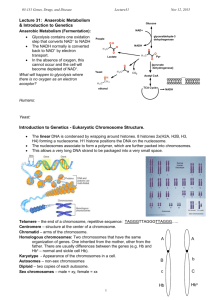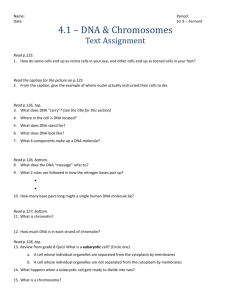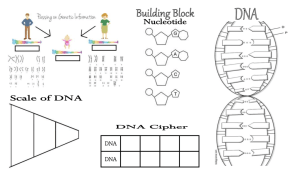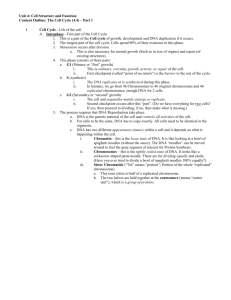- Syneratio
advertisement
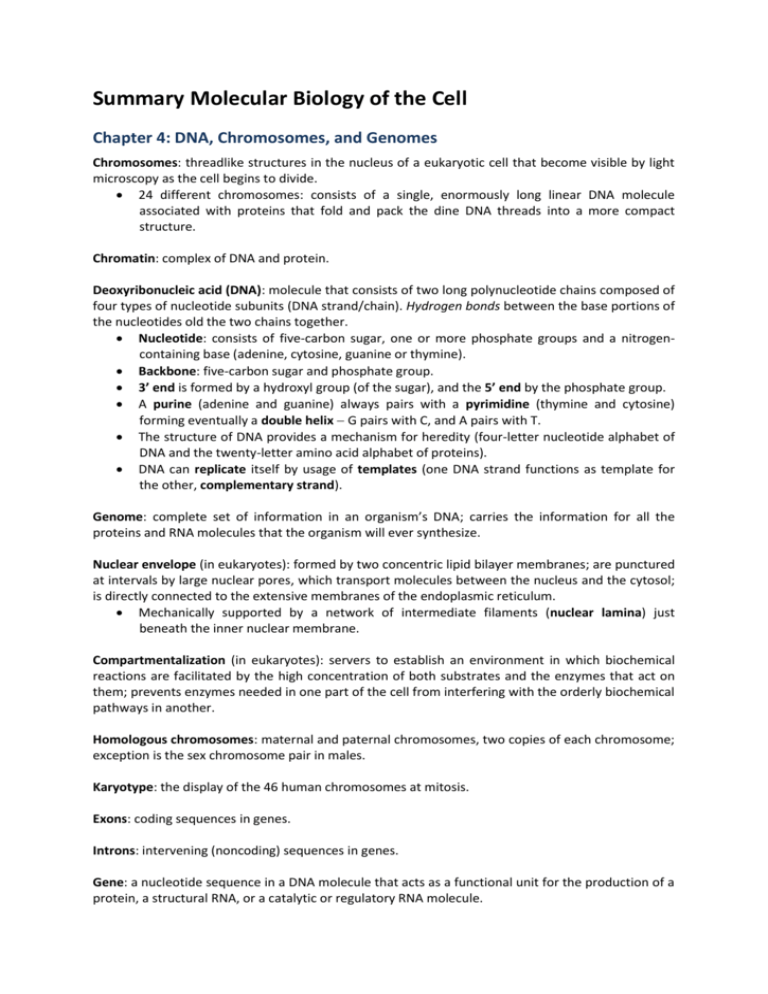
Summary Molecular Biology of the Cell Chapter 4: DNA, Chromosomes, and Genomes Chromosomes: threadlike structures in the nucleus of a eukaryotic cell that become visible by light microscopy as the cell begins to divide. 24 different chromosomes: consists of a single, enormously long linear DNA molecule associated with proteins that fold and pack the dine DNA threads into a more compact structure. Chromatin: complex of DNA and protein. Deoxyribonucleic acid (DNA): molecule that consists of two long polynucleotide chains composed of four types of nucleotide subunits (DNA strand/chain). Hydrogen bonds between the base portions of the nucleotides old the two chains together. Nucleotide: consists of five-carbon sugar, one or more phosphate groups and a nitrogencontaining base (adenine, cytosine, guanine or thymine). Backbone: five-carbon sugar and phosphate group. 3’ end is formed by a hydroxyl group (of the sugar), and the 5’ end by the phosphate group. A purine (adenine and guanine) always pairs with a pyrimidine (thymine and cytosine) forming eventually a double helix G pairs with C, and A pairs with T. The structure of DNA provides a mechanism for heredity (four-letter nucleotide alphabet of DNA and the twenty-letter amino acid alphabet of proteins). DNA can replicate itself by usage of templates (one DNA strand functions as template for the other, complementary strand). Genome: complete set of information in an organism’s DNA; carries the information for all the proteins and RNA molecules that the organism will ever synthesize. Nuclear envelope (in eukaryotes): formed by two concentric lipid bilayer membranes; are punctured at intervals by large nuclear pores, which transport molecules between the nucleus and the cytosol; is directly connected to the extensive membranes of the endoplasmic reticulum. Mechanically supported by a network of intermediate filaments (nuclear lamina) just beneath the inner nuclear membrane. Compartmentalization (in eukaryotes): servers to establish an environment in which biochemical reactions are facilitated by the high concentration of both substrates and the enzymes that act on them; prevents enzymes needed in one part of the cell from interfering with the orderly biochemical pathways in another. Homologous chromosomes: maternal and paternal chromosomes, two copies of each chromosome; exception is the sex chromosome pair in males. Karyotype: the display of the 46 human chromosomes at mitosis. Exons: coding sequences in genes. Introns: intervening (noncoding) sequences in genes. Gene: a nucleotide sequence in a DNA molecule that acts as a functional unit for the production of a protein, a structural RNA, or a catalytic or regulatory RNA molecule. Regulatory DNA sequences: are responsible for ensuring that the gene is turned on or off at the proper time, expressed at the appropriate level, and only in the proper type of cell. Conserved synteny: large blocks of our genomes contain genes in the same order in different mammals. During interphase chromosomes are replicated, and during mitosis they become highly condensed (mitotic chromosomes) and then are separated and distributed to the two daughter nuclei. Each DNA molecule that forms a linear chromosome must contain a centromere, two telomeres, and replication origins. Replication origin: location at which duplication of the DNA begins. A protein complex called a kinetochore forms at the centromere and attaches the duplicated chromosomes to the mitotic spindle, allowing them to be pulled apart. Telomeres: ends of a chromosome contain repeated nucleotide sequences that enable the ends of chromosomes to be efficiently replicated, protect the ends of the chromosomes. Proteins that bind to the DNA to form eukaryotic chromosomes are traditionally divided into two general classes: the histones and the nonhistone chromosomal proteins. Histones are responsible for the first and most basic level of chromosome packing, the nucleosome. Each nucleosome core particle consists of a complex of eight histone proteins – two molecules each of histones H2A, H2B, H3 en H4 – and double-stranded DNA (around 200 nucleotide pairs of DNA). Histone octamer: forms a protein core around which the double-stranded DNA is wound. All share the structural motif (histone fold) formed from three α helices connected by two loops. Numerous hydrophobic interactions and salt linkages hold DNA and protein together, also bonds between amino acid backbone of the histones and the phosphodiester backbone of the DNA. More than one-fifth of the amino acids in each of the core histones are either lysine or arginine (basic side chains) for optimal bonding with the negatively charged DNA backbone. The DNA strand (1.7 turns) is wrapped in a left-handed coil. Each of the core histones has an N-terminal amino acid “tail”, which extends out from the DNAhistone core. These tails are subject to several different types of covalent modifications that in turn control critical aspects of chromatin structure and function. Nucleosomes have a dynamic structure and are frequently subjected to changes catalyzed by ATPdependent chromatin-remodeling complexes (evolutionary related to the DNA helicases). Remodeling complexes can catalyze nucleosome sliding. Important factors that cause the nucleosomes to stack so tightly on each other in a 30-nm fiber are: Most notably the H4 tail and an additional histone, histone H1. This structure is highly dynamic to allow access to the DNA (spontaneous unwrapping and rewrapping in the nucleosome itself). Epigenetics: form of inheritance that is superimposed on the genetic inheritance based on DNA – for instance the covalent modification of histones in nucleosomes. These covalent modifications serve as recognition sites for protein modules that bring specific protein complexes to the appropriate regions of chromatin, thereby producing specific effects on gene expression or inducing other biological functions. Heterochromatin: highly condensed chromatin, highly organized and unusually resistant to gene expression. Present in many locations along chromosomes, although highly concentrated in specific regions (centromeres and telomeres). Contains very few genes or are hereby turned off or silenced. Heterochromatin is normally prevented from spreading into adjacent regions of euchromatin by special barrier DNA sequences. Euchromatin: less condensed chromatin and is more readily accessible for gene expression. The core histones are covalently modified at many different sites – a large number of these sidechain modifications occur on the eight relatively unstructured N-terminal ‘histone tails’ that protrude from the nucleosome. Acetylation of lysines (tends to loosen chromatin structure), mono-, di- and tri-methylation of lysines, and phosphorylation of serines. All the modifications are reversible. Modifications by enzymes such as histone acetyl transferases (HATs) and histone deacetylase complexes (HDACs) The initial recruitment of these enzymes depends on gene regulatory proteins that bind to specific DNA sequences along chromosomes. The covalent modifications and the histone variants act in concert to produce a histone-code that helps to determine biological function. Code-reader complex: recognizes different histone modifications and bind other protein complexes that execute an appropriate biological function at the right time. A complex of code-reader and code-writer proteins can spread specific chromatin modifications for long distances along a chromosome. Each centromere is embedded in a stretch of special centric heterochromatin that persists throughout interphase (contains a centromere-specific variant H3 histone, CENP-A). In the centromere of prokaryotes there is a specific DNA sequence of approximately 125 nucleotide pairs. Eukaryotes are more complex and do not seem to contain a centromere-specific DNA sequence, but consists of short, repeated DNA sequences (alpha satellite DNA). The chromatin in each band appears dark because the DNA is more condensed than the DNA in interbands; it may also contain a higher proportion of proteins. Chromosome puffs arise from the decondensation of a single chromosome band. The 46 interphase chromosomes in a human cell tend to occupy its own discrete territory within the nucleus. The nucleolus is the cell’s site of ribosome assembly and maturation, as well as the place where many other specialized reactions occur. The condensation of interphase chromosomes into mitotic chromosomes begins in early M phase, and it is intimately connected with the progression of the cell cycle. During M phase, gene expression shuts down, and specific modifications are made to histones that help to reorganize the chromatin as it compacts. The compaction is aided by a class of proteins called condensins. Homologous genes: genes that are similar in both their nucleotide sequence and function because of a common ancestry. Phylogenetic tree: e.g. the tree describing the divergence of humans from the great apes. Purifying selection: selection that eliminates individuals carrying mutations that interfere with important genetic functions. Because all vertebrates experience a continuous process of DNA loss and DNA addition, the size of a genome merely depends on the balance between these opposing processes acting over millions of years. Pseudogene: nucleotide sequence of DNA closely resembling that of a functional gene, but containing numerous mutations that prevent its proper expresion.


